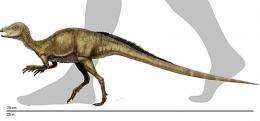Scientists find fossil bones of smallest dinosaur

(PhysOrg.com) -- A new dinosaur species, Fruitadens haagarorum, is the smallest dinosaur ever discovered from North America. The tiny Fruitadens weighed less than a kilogram (two pounds) and was just 70 cm (28 inches) in length.
The remarkable fossils of Fruitadens, housed at the Natural History Museum of Los Angeles County were discovered in Colorado in the late 1970s. The species was recently identified and named by an international team of scientists, led by Dr. Richard Butler of the Bavarian State Collection for Paleontology, Munich, Germany, and including Natural History Museum Dinosaur Institute Director Dr. Luis Chiappe. Their findings appear today in the British science journal Proceedings of the Royal Society B.
For the scientific team, Fruitadens is just the latest step in unraveling the astounding story of dinosaur evolution.
“Fruitadens comes from a series of rocks, the Morrison Formation, which paleontologists have studied intensively for 130 years, and from which dozens of dinosaur species are already known,” says Butler. “Yet it is still possible to discover completely unique and remarkable species. If dinosaur ecosystems were that diverse, who knows what astonishing beasts are waiting for us to discover?”
The agile, fast-running Fruitadens lived in the Late Jurassic period (about 150 million years ago). He darted between the legs of some of the largest known long-necked sauropod dinosaurs, such as Brachiosaurus, and giant meat-eating dinosaurs such as Allosaurus and Torvosaurus.
Parts of the skull, vertebrae, arms and legs of four individuals are known—all of them housed at the Natural History Museum of Los Angeles County and some on view now in the Museum’s Dino Lab. By examining the fine-scale internal structure of the leg-bones, the team discovered that the largest individuals of Fruitadens were probably young adults of four years age. Growth was close to completion, indicating that Fruitadens was one of the smallest of all dinosaurs.
“This discovery highlights how strongly biased against the smallest spectrum of body sizes is the dinosaur fossil record and how critical it is to learn more about the tiny dinosaurs that lived alongside the popular behemoths,” Chiappe says. “Fruitadens is the smallest known dinosaur from North America; it’s one of smallest dinosaurs, period. It tells you once again how dinosaurs range in size, from animals that were barely two pounds in weight to animals that were tens of tons in weight. That knowledge opens the door to further research about their feeding strategies and diets.”
Fruitadens belonged to the heterodontosaurids, an important group of early dinosaurs previously unknown from North America, and is one of the latest surviving members of this group. Like other heterodontosaurids, Fruitadens possessed an unusual combination of different shaped teeth, including a canine-like tooth at the front of the lower jaw and leaf-shaped teeth in the cheek region. This unusual dentition, combined with the small body size, led the scientific team to suggest that Fruitadens may have fed upon both plants and animals.
“People usually classify dinosaurs by whether they are meat or plant eaters,” Chiappe says. “But in reality, the more we know about their diversity, we recognize some of them were in between. We’re realizing the way of classifying of them as either plant or meat eater is too simplistic. This is a good example of an animal that probably lived on both, plants and bugs, at the same time.”
The genus name Fruitadens refers to the area of Fruita in Colorado, where the fossils were discovered, and the Latin word for tooth. The specific name (a.k.a. the second part of binominal nomenclature name) haagarorum honors Natural History Museum of Los Angeles County donor and Board of Trustees President, Paul Haaga and family. Fruitadens haagarorum will appear in several different contexts inside the Museum: today and in Summer 2011 when a new exhibit Dinosaur Mysteries opens to the public
In addition to Butler and Chiappe, other authors are Dr. Laura Porro of the University of Chicago; Dr. Peter Galton of the University of Bridgeport; Dr. Gregory Erickson of the Florida State University; and Dr. Don Henderson of the Royal Tyrrell Museum of Paleontology, Canada.
Provided by Natural History Museum of Los Angeles County

















